South Australia and the rest
Before the scheduled March 2018 election the SA Government announced a new target of 75% renewable electricity for the state by 2025; at the time about 50% of SA's electricity was being generated by renewables.
Fifteen years earlier SA had near zero renewable energy.
(SA and Tasmania were much smaller energy users than the other states.)
It is arguable whether the SA government is responsible for the outstanding rate of renewable energy developments in the state or whether they just allowed it to happen.
What can be said in favour of the SA governments from at least 2003 to 2018 is that they have never stood in the way of renewable energy development while most other state governments (while in the hands of Liberal-National coalitions) have at one time or another been strongly opposed; and, of course, the Federal Coalition government has a consistent record of supporting fossil fuels at the expense of renewables.
Australian Capital Territory
The outstanding government in Australian is quite definitely that of the
Australian Capital Territory which has a
target of
90% renewable energy by 2020.
This is particularly meaningful because the target date is only five years
away; a target of 2025 or 2030 means little to a government because they
tend to think and plan only one term toward the future.
The ACT government has contracted three wind farms to generate power toward
the target by 2017 (this section was written 2015/02/07).
The 200MW of installed capacity contracted is expected to meet about a third
of the ACT's 2020 electricity needs.
Tasmania
As of 2018 Tasmania had around 90% renewable electricity, by far the greatest part of this being hydro-power from developments that were several decades old.
Not many dams have been built in recent decades.
Many of the places best suited for hydro-power dams have already been used
and large dams cause major environmental damage.
However,
run-of-river hydro systems are about as environmentally friendly as
any hydro-power scheme can be and there is scope for more run-of-river
installations in Australia.
|
|
| A small part of the Tomlin's hydro scheme
|
|---|

| | Photo credit ABC Landline
| |
Nigel Tomlin his and son, Josh, who are farmers in southern Tasmania, are
working on a visionary
2 GWh/year hydro scheme.
They have already built a
100 MWh/year run-of-the-river hydro
scheme on the Jones River near Ellendale, they know what they are doing.
The Abbott
Government's anti-renewable policies will make
any more imaginative and innovative run-of-river hydro schemes such as the
Tomlin's unlikely in the foreseeable future.
| Installed capacity | Annual generation
| Capacity factor
|
|---|
| Snowy hydro
| 3.8GW
| 4.5TWh
| 13.5%
|
|---|
| Tasmanian hydro | 2.6GW | 9.0TWh
| 39.5%
|
|---|
The figures for installed capacity and annual generation above are from
Wikipedia, I calculated the capacity factor from the other figures.
Note that the Tasmanian hydro installations are far more utilised than are
the Snowy hydro installations.
The main difference would be in that Tasmania's hydro power stations provide
most of Tasmania's electricity needs while the Snowy only provides power in
time of high demand and high wholesale prices(?)
Also see
Solar power in Australia (2): recent
significant developments in solar power in Australia.
|
|
| Solar PV power capacity in Australia, 2001 to 2014
|
|---|
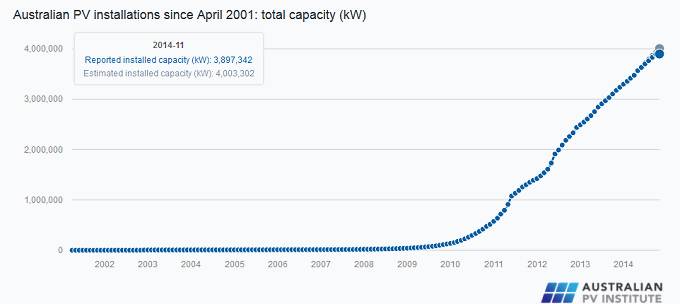
| | Graph credit Australian PV Institute
| |
As shown in the graph on the right total solar PV installations in
Australia toward the end of 2014 were near 4GW.
Of this about 3.5GW was small-scale roof-top.
| |
| Biggest solar power installation in each state
|
|---|
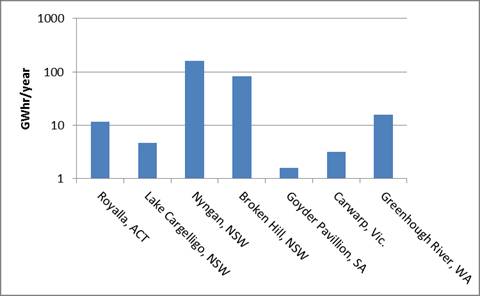
| | Graph created 2014/12/13
| |
In this section I have concentrated on the biggest solar power installations
in each state.
New South Wales is easily the front runner in late 2014, although the
Australian Capital Territory is doing very well in relation to its small
size.
South Australia (my state) is the leader in household solar PV installations
per capita.
The annual generation figures below and on the right are based on a capacity
factor of 18%.
The Nyngan and Broken Hill projects shown on the graph are, at the time of
writing, under construction.
Queensland's Kogan Creek Solar Boost, mentioned below, cannot be plotted on
the graph because it does not generate electricity; it is also still under
construction.
Australian Capital Territory
Royalla
| |
| Royalla Solar Farm
|
|---|

| | Image credit, ABC. Artist's impression
| |
The 20MW Royalla solar farm was opened on 2014/09/03.
It is about 17km south of Canberra.
At the time if writing (December, 2014) this is the largest solar power
station in Australia (which is pathetic by world standards).
The ACT is the most progressive of the states and teritories of Australia in
that it has a policy for 90% renewable energy by 2020.
This solar farm is the first of several planned in the ACT.
| Name | Installed capacity | Annual generation
|
|---|
| Royalla | 20MW | 11.7GWh
|
New South Wales
NSW is well ahead of the other states in big solar power developments
in late 2014 and will remain so for at least a year because of the Nyngan and
Broken Hill developments.
Lake Cargelligo
| |
| Google Earth image
|
|---|
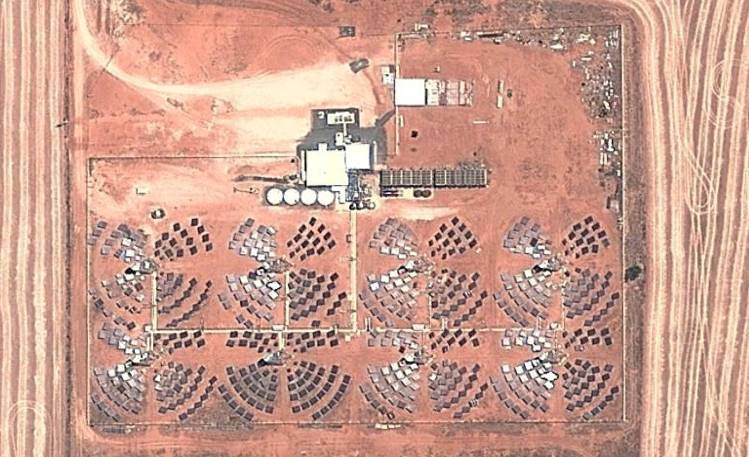
| NSW, Latitude -33.3115°, Longitude 146.4097°
Click on the image to view full size; use your browser's back
arrow to come back to this page after viewing.
| |
| Name | Installed capacity | Annual generation
|
|---|
| L. Cargelligo | 3MW | 4.7GWh
|
NSW; Liddell solar booster
| |
| Liddell solar boosters
|
|---|

| | New and old
| |
In October 2012, 9.3MW concentrating solar thermal came into operation at the
Liddell coal fired power station in NSW Hunter Valley.
The installation provides a 'steam boost' for the power station.
This is the second, or even third, phase of solar thermal
installations at the Liddell Power
Station.
Thanks to Bill Gresham for this.
NSW; Nyngan, proposed

|
An artist's impression on the Nyngan solar power station
Image credit: AGL
|
| Name | Installed capacity | Annual generation
|
|---|
| Nyngan | 102MW
| 161GWh
|
Construction started in early 2014, completion is due by June
2015.
When completed this will be by far the biggest solar power station in
Australia.
I have a drone photo of Nygan Solar Farm when completed on another page on this site.
NSW; Broken Hill, proposed

|
An artist's impression on the Broken Hill solar power
station
Image credit: AGL
|
| Name | Installed capacity | Annual generation
|
|---|
| Broken Hill
| 53MW | 84GWh
|
Construction started in July 2014, completion is due by November
2015.
I have a drone photo of the Broken Hill Solar Farm after completion an another page on this site.
Queensland
Kogan Creek Solar Boost Project
Quoting from the
Wikipedia
article:
"The project involves the installation of a CLFR [compact linear fresnel
reflector] solar thermal system
capable of generating 44 MW electrical at peak solar conditions.
Steam from the solar field is first further heated and then used to power
the intermediate pressure turbine, thereby displacing coal.
The project will reduce carbon emissions by about 35,000 tonnes per year,
which is 0.8% of emissions, at a cost of only A$3 per tonne of carbon for
the first year's emissions alone."
Work started on the project in 2011, but "difficulties with the project and
commercial issues mean that it will now not be commissioned until 2015."
| Name | Installed capacity | Expected abatement
|
|---|
| Kogan Creek
| 44MW | 35,000t/yr
|
It is interesting that Queensland's biggest solar power installation will
not generate electricity but will rather serve as an adjunct to a
coal-fired power station.
Queensland does have plans for a sizable solar photovoltaic installation, the
Valdora Solar Farm (10MW) proposed for the Sunshine Coast in 2015.
South Australia
South Australia has very little large-scale solar compared to several
of the other states.
However, what it lacks in large-scale solar it more than makes up for in
small-scale roof-top solar and particularly wind power.
Goyder Pavillion, Wayville Showgrounds
| Name | Installed capacity | Annual generation
|
|---|
| Goyder | 1MW | 1.6GWh
|
Victoria
Carwarp
| |
| Carwarp Solar Farm
|
|---|
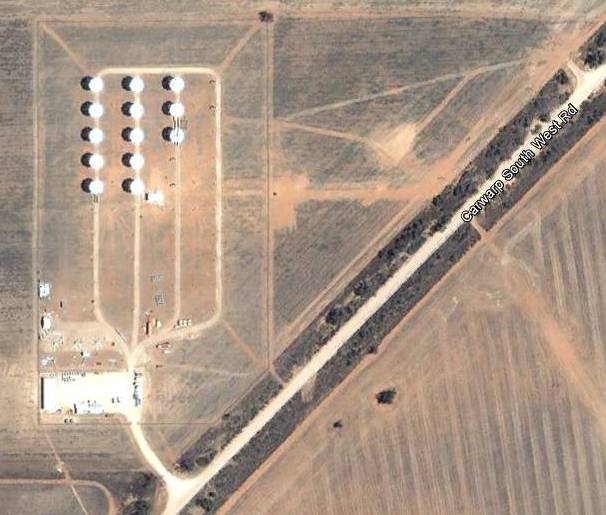
| | Google Earth image; downloaded 2013/02/28
| |
ReNewEconomy carried an
article
on 2013/08/17 noting that this "power plant was officiall opened today",
and gave the installed capacity as 1.5MW.
Solar Systems' pdf page on the project stated that it was
expected to cost about $1 million, have an installed capacity of 2 MW,
and generate 4 to 4.5 GWh per annum.
| Name | Installed capacity | Annual generation
|
|---|
| Carwarp | 2MW | 3.2GWh
|
As mentioned elsewhere, the annual generation here is based on an
assumed capacity factor of 18%.
Western Australia
Greenhough River
| |
| Google Earth image
|
|---|

| |
Click on the image to view full size; use your browser's back
arrow to come back to this page after viewing.
| |
| Name | Installed capacity | Annual generation
|
|---|
| Greenhough River | 10MW | 15.8GWh
|
CORENA is an inovative crowd-funding
group who collect public donations and use the money to install solar PV
systems to deserving organisations.
The money involved is treated like a loan and is gradually paid back out of
the savings in power bills.
At the time of writing (2014/01/02) three projects have been funded and
installed.
First (pilot) Stage
| |
| Initial solar power collector
|
|---|
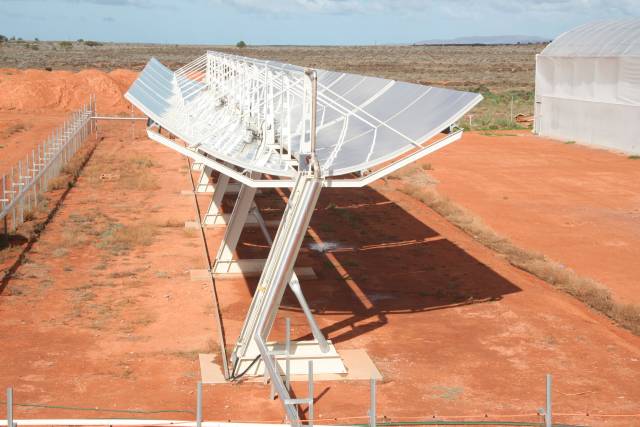
| | Photo taken 2013/05/12
| |
| |
|
I've placed a piece about the second (main) stage on
another page.
|
|
This is a very innovative project that uses solar power and saline
water to grow vegetables in an arid environment.
The first stage was built around 2012.
A much bigger second stage, 40 MW, was built in (?) early 2017.
Links: ABC article,
Sundrop Farms
The outstanding point of this development is its innovation.
This is the only such development in Australia, and possibly in the world.
While Sundrop Farms has offices in London, Dubai and Adelaide, they have
only the one farm near Port Augusta.
An partial explanation of how it works was
televised on
the ABC's Catalyst science program back in 2013.
There's another
article, by John Mathews, February 2014, on The Conversation.
Neither of these explain in any detail how the whole thing works and both
refer mainly to the first, pilot scale, operation.
The Clean Energy Finance Corporation (which the anti-renewable
anti-environment
Abbott/Turnbull
government has attempted to close down) has helped find
finance for this innovative enterprise.
Second (main) Stage
| Image date 2016/03/14
|
|---|

|
| Under construction
|
The Sundrop Farms Net site provides quite a bit of information, they also have a
Facebook page.
Danish company,
Aalborg CSP built the solar power system for Sundrop, as of 2018/07/31 they had a very good video on
YouTube explaining how it works.
| |
| Electric car charging station at The Macadamia Castle
|
|---|

| Image credit: Margaret Burin and the ABC.
Tony Gilding owns The Macadamia Castle.
| |
In early December 2014 there were announcements of "the first solar powered
electric car charging station in Australia".
One contender for this distinction is The Macadamia Castle (photo on the
rignt); more information on it is available from the
ABC.
However, it seems that the distinction may actually belong to
Kangaroo Island.
It appears that the KI solar installations and car-charging stations are
integrated into the local power grid.
This means that power generated by the solar panels that is excess to that
needed for charging electric cars can be used rather than going to waste.
Tesla have announced that they are considering setting up a
network
of solar powered car charging stations in Australia, 2014/10/31.
| |

| Echidna found on side of road to Cape Du Couedic.
KI is known for its wildlife and scenery.
|
|
|
|
|

| | Remarkable Rocks, KI
|
|
|
|
|
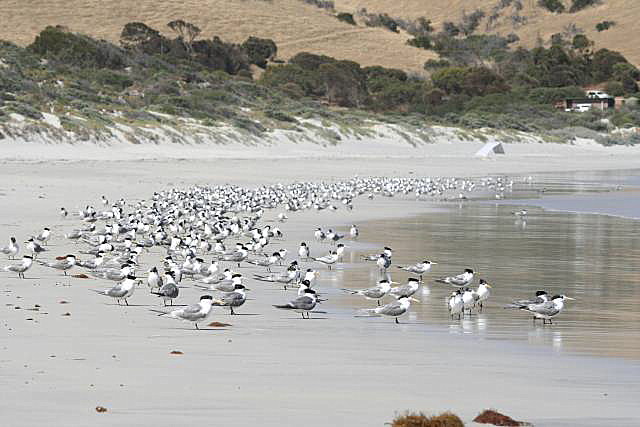
| | Snelling Beach, KI
|
|
Kangaroo Island (about 100km south of Adelaide) has what is quite probably
the first solar-powered electric car charging stations in Australia.
(Both the solar PV installations and the car-charging stations are integrated
into the local power grid.
This means that the full capacity of the solar can be used and there will
always be power at the car-charging stations.)
I inquired of the Kangaroo Island Council and received the following
email from Andrew Boardman, Chief Executive Officer, in reply...
We have 6 stations – two at the Airport, 1 in each of the main
Townships (Kingscote, Parndana, American River and Penneshaw).
We have two fixed private charging sockets at Kingscote Offices and one at
the Kingscote Works Depot.
The airport has 50KW of tracking solar (4 x 12.5KW stations); the Kingscote
Office has 15KW of fixed roof solar and the Kingscote depot has 5KW fixed
roof solar contributing to demand. All our electricity sold through the
Charge-point infrastructure is "green" power.
All of this infrastructure was installed in 2013.
We have three Nissan Leaf EV's – one used by Council and 2 leased out
to a local car hire company who hire them out to the public (from the
airport) – currently $60/day as opposed to the normal $110/day for a
petrol car.
We retail charges through these station – $16 for a full 25KW charge.
Since installing the infrastructure three Community Members have bought
EV's (all three Mitsubishi I-Mievs) and we have had EV tourists come over
from the mainland with their vehicles – just proving that if you build
it they will come!!
Those people visiting Kingscote on business or the like are starting to use
them a lot.
Council have also just leased two Mitsubishi Outlander PHEV's which access
the charging infrastructure as well.
The PHEV work better for us as the Island is 150km long and to go west of
Parndana is an issue as there are no chargers out this way – and a
mains network that is too "skinny" to install chargers down there.
I would like to build some combined solar / wind
[KI has huge wind power potential]
/ battery / chargers / grid
connect stations down that end of the Island with a view of getting into
smart grid and using the infrastructure to mitigate demand in the grid as
well as be development nodes.
Need money and some partners to play with though.
Have had some interesting conversations with Flinders Uni who are
considering roof solar and changing some of their fleet over to EV.
Also with GEITS with their floating solar options for bodies of water such
as our Community wastewater treated water storage lagoons and TINDO with
their potential install for free and buy power back through a power purchase
agreement.
We're in the process of talking to Tesla about their entry to the market
– their range and the new X model AWD would be ideal for our situation
and we think we could move the specialist high tour providers currently
using Mercs / Land Rover / Land Cruiser 4WD or Vans could move to these.
Particularly if we pursue the supercharger format coupled to neighbourhood
smart grid and renewables.
We have 19,000ha of maturing bluegum on the island without a commercial home
as yet – we are hoping this will mobilise in the next couple of years
and this might open up some significant biomass-derived opportunities for
heat / power / fuels – we use 6M litres of diesel on the Island
– 1.8M by two ferries running between us and the mainland – I
would really like to get these on fully synthetic diesel derived from the
bluegums...
It seems that the KI council is very progressive.
It is a pity that our
federal government isn't equally so.
|
|
| Biggest wind farms in each state
|
|---|

| | Graph created 2014/12/14
| |
In this section I have concentrated mainly on the biggest wind farms in each
state.
The annual generation figures below and on the right are based on the
weighted average capacity factor for SE Australian wind farms (35%).
New South Wales
Gullen Range?
| Name | Number of Turbines | Installed capacity | Annual generation
|
|---|
| Gullen Range
| 73 | 165.5MW | 507GWh
|
Queesland
Windy Hill
| |
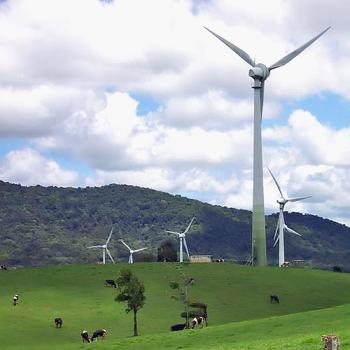
| | Photo thanks to Wayne Roddom, Darwin
|
|
Windy Hill Wind Farm was one of the earliest in Australia, being built in
the year 2000.
It is about one fourteenth the size of Gullen Range (NSW) or Musselroe (Tas.)
wind farms.
No wind farms have been built in Queensland since 2000, although several
have been proposed.
| Name | Number of Turbines | Installed capacity | Annual generation
|
|---|
| Windy Hill
| 20 | 12MW | 37GWh
|
South Australia
South Australia is the leading state in wind power, having about 45% of
Australia's total.
Mid North SA has more that half of the state's wind power and 25% of the nation's wind power.
Mid North SA is probably the first region in Australia to be carbon-negative.
Snowtown, two stages
| The completed Snowtown Wind Farm, first and second stages;
2014/06/11
|
|---|

|
| Click on the image to view full size; use your browser's back
arrow to come back to this page after viewing.
|
| Name | Number of Turbines | Installed capacity | Annual generation
|
|---|
| Snowtown
| 138 | 371MW | 1137GWh
|
Ceres; proposed
| Name | Number of Turbines | Installed capacity | Annual generation
|
|---|
| Ceres
| 197 | 670MW? | 2050GWh
|
Tasmania
Musselroe
| Name | Number of Turbines | Installed capacity | Annual generation
|
|---|
| Musselroe
| 56 | 168MW | 515GWh
|
Victoria
Macarthur

|
| A few of the Macarthur wind turbines
|
| Name | Number of Turbines | Installed capacity | Annual generation
|
|---|
| Macarthur
| 140 | 420MW | 1288GWh
|
Western Australia
Collgar
|
|
| A small part of Collgar Wind Farm – while under construction
|
|---|
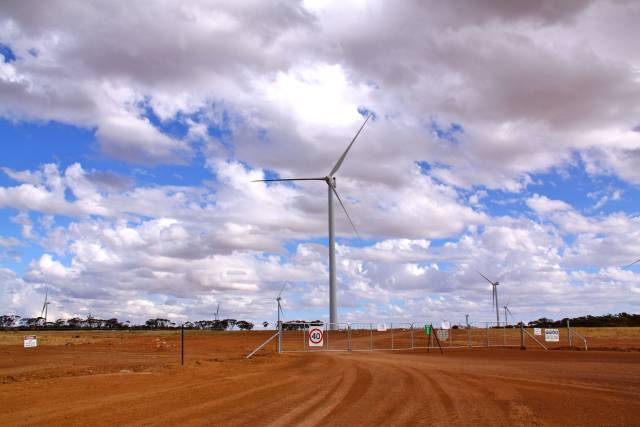
| Photo taken April 26, 2011
Image credit Diana House
| |
| Name | Number of Turbines | Installed capacity | Annual generation
|
|---|
| Collgar
| 111 | 206MW | 632GWh
|
What is happening in Australia in 2018
In Australia all the action on renewable-energy-to-gas development seems to be happening in South Australia and seems to be confined to using renewably generated electricity to hydrogen.
Hydrogen can be used to produce methane, ammonia or biogas, but there seems to be no action on this in Australia on a pilot or larger scale.
Renewable energy to hydrogen proposals/developments
| |
A page on the subject
On 2018/05/02 I wrote a
separate page on Power to gas (P2G) as it was developing in Australia.
|
|
Nick Harmsen posted an
article on ABC on-line news on 2017/08/08.
It described a trial to convert excess electricity to hydrogen gas using
electrolysis to take place in Kidman Park, Adelaide in 2018.
South Australia has more wind power than any other Australian state, but
consumes far less electricity than the more populous states.
The interconnectors between SA and the eastern states have limited capacity
to export excess power when the wind farms are in full production, so there
are times when electricity is available at zero price.
The trial will look into the practicality of converting some of this
excess electricity into hydrogen gas and injecting it into the existing gas
distribution network where it will mix with the natural gas.
The article stated that there is no problem mixing up to at least 10 percent
of hydrogen in natural gas.
Second power-to-gas trial announced
| |
|
|
|
|
While PM Turnbull puts lipstick on a pig
PM Turnbull has given $50m of our money to a pilot plant to turn
160 tonnes of Victorian brown coal into 3 tonnes of hydrogen.
The great advantage of hydrogen as a fuel is that when burned nothing but steam is released; but if a huge amount of coal is burned to produce the hydrogen, where is the point?
| |
Sophie Vorrath wrote a
piece for Renew Economy on 2018/02/21.
"South Australia is set to host its second hydrogen production and distribution facility, with the construction of a 1.25MW Siemens electrolyser that will produce hydrogen using electricity from the grid and potentially on-site solar."
"The hydrogen produced by the Tonsley-based power-to-gas demonstration plant – to be known as Hydrogen Park SA (HyP SA) – will be injected into AGIG’s local gas network."
This had been announced by the SA Premier the same day.
Innovation?
This is the sort of innovation that Australia needs as we change from fossil
fuels to renewable energy.
Prime Minister
Turnbull has promised innovation, but his
government has been very backward in actually supporting innovation.
Power to gas links
On this page
Hydrogen and energy: the production and uses, and advantages and disadvantages, of hydrogen as a fuel
Power to gas (P2G) in Australia
External links
Wikipedia, Power-to-Gas
Renewable Power-to-Gas: A technological and economic review; Manuel Götza, Jonathan Lefebvreb, Friedemann Mörsa, Amy McDaniel Koch, Frank Graf, Siegfried Bajohr, Rainer Reimer, Thomas Kolb; Elsevier Renewable Energy, Volume 85, January 2016.




















